Introduction: Compression Socks Are Not for Everyone
Compression socks are designed to support blood flow, relieve swelling, and reduce fatigue. For many people, they work well. But not everyone should wear them.
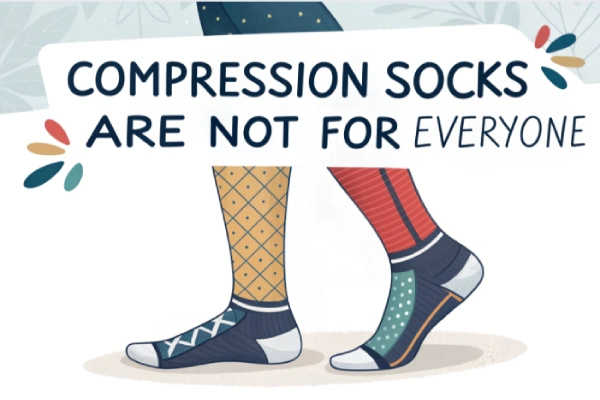
Certain medical conditions make compression socks unsafe. In some cases, they can even cause harm. That’s why it’s important to understand the risks.
If you’re a brand or retailer, knowing who should not wear compression socks helps you protect your customers and reduce complaints. It also shows that you understand both the benefits of compression socks and the potential side effects when used incorrectly.
So what do compression socks do—and who should avoid them? Let’s break it down clearly and practically.
Who Should Not Wear Compression Socks
Compression therapy is beneficial—but only when it’s used correctly and by the right population.
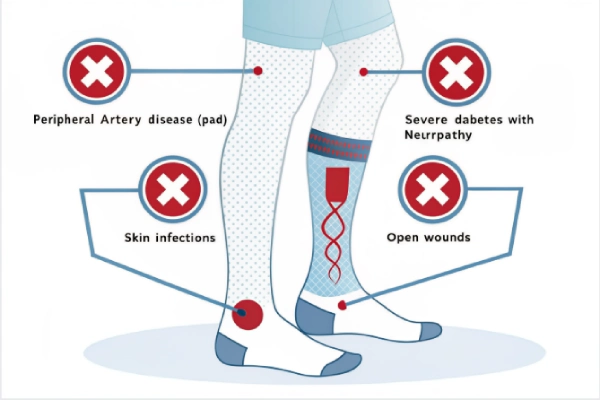
Patients with Serious Circulatory Disorders
- Peripheral Arterial Disease (PAD)
People with advanced PAD already suffer from reduced blood flow to the lower limbs. Wearing compression socks may further limit arterial supply, potentially leading to tissue damage or ulceration. These patients typically experience cold feet, leg cramps during walking (claudication), and weak pulse in their legs. - Severe Heart Failure
In late-stage heart failure, increased venous return caused by compression can overload the heart, raising the risk of decompensation or pulmonary edema. These users should avoid compression garments unless supervised by a cardiologist. - Vasculitis Patients
Autoimmune conditions affecting blood vessels—such as vasculitis—can lead to fragile vessel walls and poor healing. Compression may aggravate the inflammation and cause bruising or skin injury.
Users with Skin-Related Contraindications
- Open Wounds or Ulcers
Compression socks trap moisture and pressure against the skin. When worn over open wounds or ulcers, they can delay healing or even cause infection. - Severe Skin Infections
Fungal infections, cellulitis, or inflamed dermatitis must be fully resolved before compression therapy begins. Closed, warm environments accelerate bacteria growth. - Allergic Skin Reactions
Some individuals may react to synthetic fibers or latex components in compression socks. Rashes, itching, or blistering are signs the user should stop wearing them immediately.
Other Medical Restrictions
Compression socks can be helpful for some diabetic users, especially those with mild edema. But for those with neuropathy, there’s a serious concern: they may not feel excessive pressure or tightness, risking unnoticed skin damage.
When selling diabetic compression socks, make sure your product:
- Has moderate or low pressure (15–20 mmHg)
- Is labeled clearly for diabetic use
- Offers wide cuffs and seamless toes to prevent pressure points
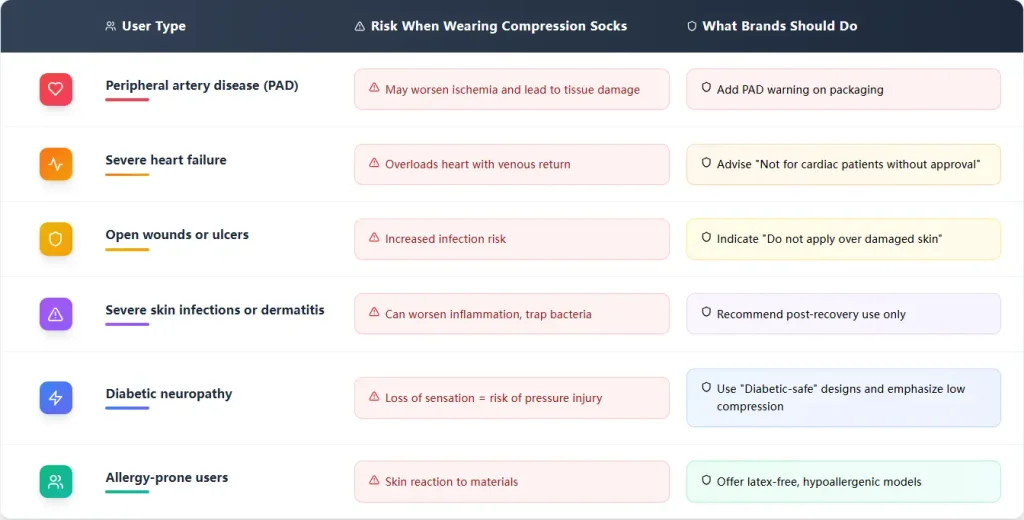
Complaint Cases:
Even high-quality compression socks can receive poor reviews. Most of the time, the issue isn’t the product itself—it’s who is wearing it or how it’s being used.
On platforms like Amazon, Walmart, or pharmacy marketplaces, you’ll find complaints such as:
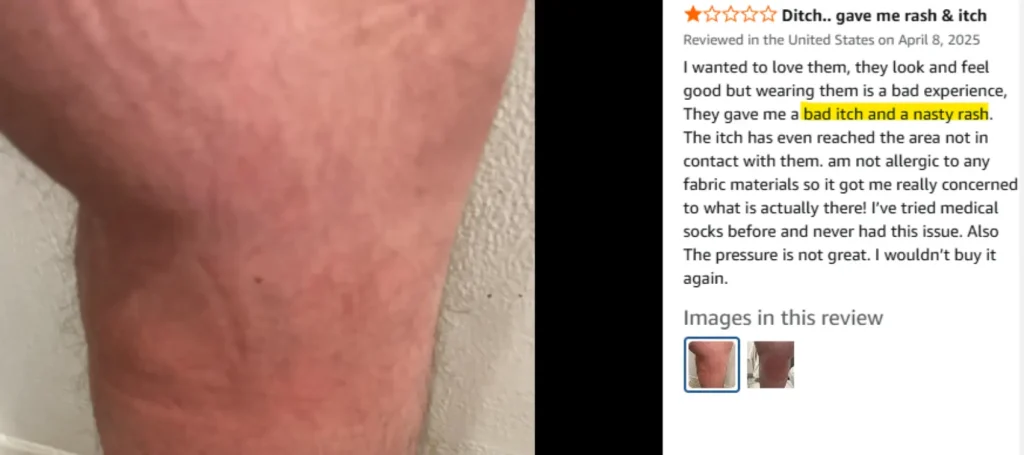
“Itchy & red after wear. My skin couldn’t breathe.”
“Made my feet more swollen after wearing.”
“Can’t wear them—felt numbness after 30 minutes.”
These negative comments often come from users who either:
- Weren’t suitable for compression therapy due to underlying conditions
- Chose the wrong compression level (e.g., 30–40 mmHg without medical need)
- Wore the socks incorrectly (e.g., folded tops, wrinkles, wrong size)
- Slept in them without guidance, which can reduce circulation for certain people
Poor reviews can hurt your brand even when your product meets all quality standards. What’s often missing is education and screening, which is a form of brand protection.
How Brands and Retailers Can Reduce Risk and Improve Product Strategy
When complaints pile up, they often point to a single issue: the wrong socks sold to the wrong user. For brands and distributors, this is a preventable problem. By adjusting your product strategy and communication, you can improve customer satisfaction while reducing returns, liability, and low-star reviews.

Label Restrictions Clearly
One of the easiest ways to avoid inappropriate use is by labeling your products properly. Warnings like:
“Do not use if you have advanced arterial disease, congestive heart failure, or diabetic nerve damage without medical advice”
…may seem obvious, but many product listings skip them entirely. For online sales especially, this text should be shown near the size or compression level selection. It’s not just about protecting the customer—it’s about protecting your brand.
Segment Your Products by Use Case
Not every customer needs the same sock. A 28-year-old nurse who’s on her feet all day needs a different product than a 78-year-old recovering from surgery.
Brands should offer compression socks in clearly segmented variations:
- Pregnancy compression socks with mild pressure and breathable fabric
- Low-compression socks (10–15 mmHg) for first-time users or elderly customers
- Compression socks for edema with extra room in the calf and ankle
- Diabetic-friendly socks with seamless toes, soft cuffs, and minimal binding
This reduces misuse and gives customers confidence that the product is made for them—not just “one-size-fits-all.”
Provide Clear Usage Instructions
Many complaints come from users who don’t know how to wear or care for compression socks.
Add value by including:
- Step-by-step how-to guides with photos or diagrams
- QR codes linking to short fitting videos
- Guidance on how long to wear socks and when to remove them
- Sizing charts based on calf circumference and ankle width
When users understand the product better, they’re more likely to wear it properly—and less likely to blame the brand for discomfort.
Use a Screening Prompt Before Checkout
Especially for online platforms, including a question prompt can prevent high-risk users from making a poor purchase. For example: “Do you have diabetes-related foot numbness, open leg wounds, or poor blood flow in your legs? If yes, consult your doctor before using this product.” It’s a simple addition that shows responsibility, prevents mis-buying, and sets your brand apart as medically informed and safety-conscious.
Usage Timing and Wearing Guidelines
Even when compression socks are the right choice medically, how they’re worn still matters. Many complaints and product returns stem from simple misunderstandings—especially about when and how long to wear them.
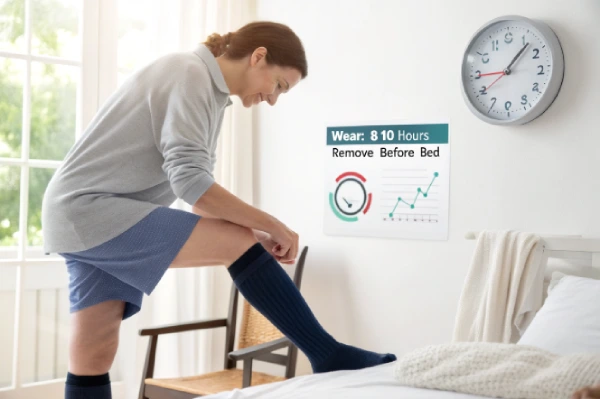
Usage Limits and Safe Practices
| Question | Best Practice |
|---|---|
| Can you sleep in compression socks? | Only under medical supervision. Avoid for general use. |
| Should you wear compression socks to bed? | No—remove before sleeping unless directed by a physician. |
| How long should they be worn daily? | 6–8 hours is generally safe for moderate compression (15–20 mmHg) |
| Can they be worn too long? | Yes. Excess wear time can cause numbness, pressure marks, or overheating |
| Should customers rotate or break during wear? | Yes. Remove during inactivity or prolonged sitting when possible |
Conclusion
Compression socks can deliver real medical and functional benefits—but only for the right people, and only when used correctly. Misuse can lead to negative reviews, product returns, or worse—harm to your end customer.
For brands, retailers, and distributors, the solution lies in education, product segmentation, and responsible packaging.
At Max Hosiery, we specialize in medical-grade and lifestyle compression socks designed for professional use cases. From custom labeling to detailed usage guides, we support B2B partners who want to build smarter, safer product lines that earn trust—not complaints.
📩 Looking to offer compression socks with clear risk labeling, medical guidance, and private-label support?
Contact Max Hosiery to develop custom solutions that help your customers wear with confidence—and avoid the risks discussed above.
FAQ: Compression Sock Safety and Usage
Can anyone wear compression socks?
No. People with arterial disease, severe diabetes complications, or skin ulcers should avoid them unless approved by a doctor.
Is it safe to wear compression socks while sleeping?
Generally not. Most people should remove them before bed unless under medical supervision.
How long should I wear compression socks during the day?
6 to 8 hours is usually enough. More than 12 hours can increase the risk of discomfort or skin issues.
Do diabetic patients need special compression socks?
Yes. Diabetic users with nerve damage should wear specially designed socks with soft cuffs and low pressure.
How do I put on compression socks correctly?
Use a step-by-step method: turn the sock inside out to the heel, slide your foot in, and unroll it gradually. QR video guides help a lot.
